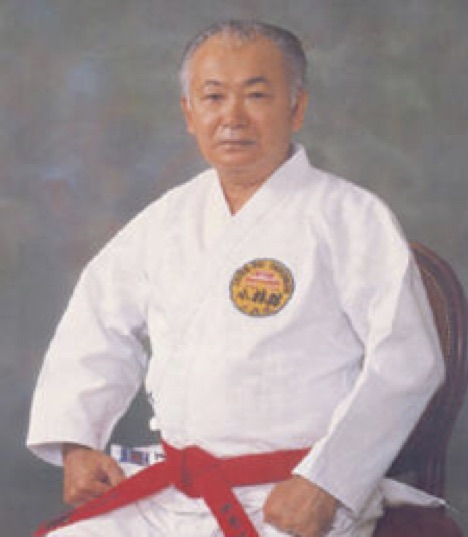
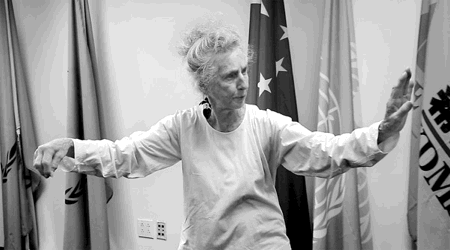 Balance is a word that you'll hear often from Doreen Hynd, a 92-year-old tai chi chuan master who has taught the martial art for almost 30 years both in the US and Canada.
Balance is a word that you'll hear often from Doreen Hynd, a 92-year-old tai chi chuan master who has taught the martial art for almost 30 years both in the US and Canada.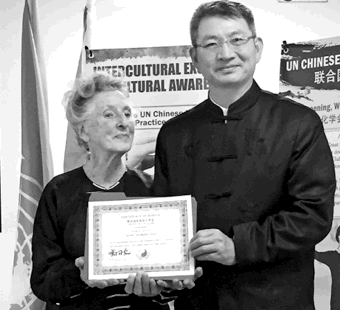 Doreen Hynd is awarded a special honor by Cao Guozhong, president of the UN Staff Recreation Council tai chi club on April 20. [Photo provided to China Daily]
Doreen Hynd is awarded a special honor by Cao Guozhong, president of the UN Staff Recreation Council tai chi club on April 20. [Photo provided to China Daily] At 9am, a bunch of us gathered at Great Kills. A couple of us were with Earth And Cup; Meghan Bryant,
a Master Trainer with the Tai Chi Institute for Health, had come up from Virginia the day before to teach
a Seated Tai Chi workshop; and a group of Wing Chun students from Staten Island. We started on the
platform at the Great Kills train station. We did Yang 8, a nice beginning form that is stationary for the
most part. We had two different variations of the form, so we worked on the differences between the
two. On the train, we taught Meghan the form. She had it down by the time we reached St. George, the
last stop.
At 9am, a bunch of us gathered at Great Kills. A couple of us were with Earth And Cup; Meghan Bryant,
a Master Trainer with the Tai Chi Institute for Health, had come up from Virginia the day before to teach
a Seated Tai Chi workshop; and a group of Wing Chun students from Staten Island. We started on the
platform at the Great Kills train station. We did Yang 8, a nice beginning form that is stationary for the
most part. We had two different variations of the form, so we worked on the differences between the
two. On the train, we taught Meghan the form. She had it down by the time we reached St. George, the
last stop.
 While we waited in the ferry terminal, we ran through the Tai Chi for Arthritis form, which is a variation
of Sun 30. There was a group of guys with a stand-up bass singing four-part harmony, old school
Motown. It provided a nice background as with then went through Yang 24. We had a group of about
30-40 people watching us pretty intently.
While we waited in the ferry terminal, we ran through the Tai Chi for Arthritis form, which is a variation
of Sun 30. There was a group of guys with a stand-up bass singing four-part harmony, old school
Motown. It provided a nice background as with then went through Yang 24. We had a group of about
30-40 people watching us pretty intently.
 On the ferry, we started to discuss what to do next. One person offered up Yang 36. Most of us didn't
know it, so he showed it to us. The form he demonstrated I originally learned as Yang 44, which I have
since come to realize is Cheng Man-Ching's 37 Postures. A rose by any other name is still .... I thought it
was appropriate to by doing Cheng's form here in New York City. One of the participants noted that it
was possible to match the flow of the form to the shifting of the ferry from side to side, as we slowed to
dock in Manhattan. This gave an added dimension to their form.
On the ferry, we started to discuss what to do next. One person offered up Yang 36. Most of us didn't
know it, so he showed it to us. The form he demonstrated I originally learned as Yang 44, which I have
since come to realize is Cheng Man-Ching's 37 Postures. A rose by any other name is still .... I thought it
was appropriate to by doing Cheng's form here in New York City. One of the participants noted that it
was possible to match the flow of the form to the shifting of the ferry from side to side, as we slowed to
dock in Manhattan. This gave an added dimension to their form.
 Our original plan was to head to Central Park. There was supposed to be a large tai chi group up there.
As we were docking, one of the Wing Chun guys got a text that Central Park was breaking up. So, we
decided to go do Tai Chi in Chinatown! While on the subway platform for the 5 train at Bowling Green,
we found some space to do Chen 36. On the train, we worked on some of the seated tai chi techniques
we learned in class the day before. I found it was possible to get some decent movement, even on the
subway.
Our original plan was to head to Central Park. There was supposed to be a large tai chi group up there.
As we were docking, one of the Wing Chun guys got a text that Central Park was breaking up. So, we
decided to go do Tai Chi in Chinatown! While on the subway platform for the 5 train at Bowling Green,
we found some space to do Chen 36. On the train, we worked on some of the seated tai chi techniques
we learned in class the day before. I found it was possible to get some decent movement, even on the
subway.
 While in Chinatown, we went to a couple martial arts stores. I was finally able to buy my little drum.
You know, that drum that Miyagi gives to Daniel in Karate Kid 2. Now I can learn the secret.....
While in Chinatown, we went to a couple martial arts stores. I was finally able to buy my little drum.
You know, that drum that Miyagi gives to Daniel in Karate Kid 2. Now I can learn the secret.....
 From here, the group decided to go in different directions. Meghan and I decided to go down to
Battery Park. I had convinced her to teach me a new form. It was a beautiful day, so was a huge crowd at
Battery Park waiting for Statue of Liberty tours. We found a little space in front of the Armory, on the
opposite side of the line from the hip/hop dancers. They chuckled at us with our slow movements. We
showed them that we could articulate to the music just like they could. They decided to move on before
full blown dance war broke out. Meghan taught me the first half on Sun 73.
From here, the group decided to go in different directions. Meghan and I decided to go down to
Battery Park. I had convinced her to teach me a new form. It was a beautiful day, so was a huge crowd at
Battery Park waiting for Statue of Liberty tours. We found a little space in front of the Armory, on the
opposite side of the line from the hip/hop dancers. They chuckled at us with our slow movements. We
showed them that we could articulate to the music just like they could. They decided to move on before
full blown dance war broke out. Meghan taught me the first half on Sun 73.
 Meghan and I barely made the 3:30pm ferry. We decided to stay and the back deck. We started to work
on Sun 73, when we looked over and saw someone taking pictures of us. It was one of the Wing Chun
we started with, making his way back home. We did some of the form, with the City at our back. On the
train ride home, we discussed our day. Throughout the whole day, we didn't have one person give us
negativity about what we were doing. We tried to be mindful of space, and letting people pass as they
needed. What we did find was at each location, we had a group of people who took the time to watch
what we were doing. It seemed to bring the intensity of the energy down a bit. Now, it wasn't a Monday
morning commuter rush, but for the moment, people seemed to be calmer than usual. We wondered if
we came at a more stressed time, could the same effect happen? Could a small group of people, just
dong tai chi, bring calm to a place, situation or circumstance? Maybe that is next year's project. Meghan
is returning to Staten Island in August to lead a Tai Chi at Work workshop. I wonder if she will include
some of our learned lessons from this experience in the curriculum. In places like Metro NYC, the
commute is sometimes just as long as the workday. Could we give people something to keep their
bodies healthy while they are commuting? Stand by as we continue to take tai chi to the streets, uuurrr
the trains, or ferries, or buses, or planes, or subways, or the workplace, or....
Meghan and I barely made the 3:30pm ferry. We decided to stay and the back deck. We started to work
on Sun 73, when we looked over and saw someone taking pictures of us. It was one of the Wing Chun
we started with, making his way back home. We did some of the form, with the City at our back. On the
train ride home, we discussed our day. Throughout the whole day, we didn't have one person give us
negativity about what we were doing. We tried to be mindful of space, and letting people pass as they
needed. What we did find was at each location, we had a group of people who took the time to watch
what we were doing. It seemed to bring the intensity of the energy down a bit. Now, it wasn't a Monday
morning commuter rush, but for the moment, people seemed to be calmer than usual. We wondered if
we came at a more stressed time, could the same effect happen? Could a small group of people, just
dong tai chi, bring calm to a place, situation or circumstance? Maybe that is next year's project. Meghan
is returning to Staten Island in August to lead a Tai Chi at Work workshop. I wonder if she will include
some of our learned lessons from this experience in the curriculum. In places like Metro NYC, the
commute is sometimes just as long as the workday. Could we give people something to keep their
bodies healthy while they are commuting? Stand by as we continue to take tai chi to the streets, uuurrr
the trains, or ferries, or buses, or planes, or subways, or the workplace, or....

 Throughout the weekend, many interesting and insightful exercises were taught by the visiting sensei from Ohio. These unique lessons, many centering on connectivity to an assailant, or minimizing the moves required to defend one's self in some situations. We took time to cement some kata (Jayne Butram Sensei), specifically Sanchin. We were able to learn more about the rhythm of the kata, the breathing required throughout, and how to make a strong, stable stance to base the kata on. Later on, we dissected basic techniques, such as high blocks, middle blocks, and chest punches. The focus on each of these basic parts was a valuable experience, and strengthening our skills and applying them to other more complex techniques was a beneficial use of time.
Throughout the weekend, many interesting and insightful exercises were taught by the visiting sensei from Ohio. These unique lessons, many centering on connectivity to an assailant, or minimizing the moves required to defend one's self in some situations. We took time to cement some kata (Jayne Butram Sensei), specifically Sanchin. We were able to learn more about the rhythm of the kata, the breathing required throughout, and how to make a strong, stable stance to base the kata on. Later on, we dissected basic techniques, such as high blocks, middle blocks, and chest punches. The focus on each of these basic parts was a valuable experience, and strengthening our skills and applying them to other more complex techniques was a beneficial use of time.
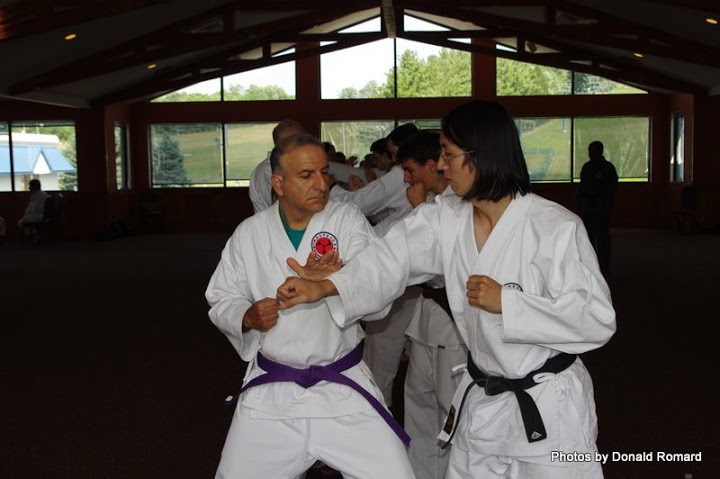 I was truly amazed of how dignified, graceful and flawless they were as they demonstrated their mastery of kata. I was somewhat uncomfortable at the start, due to the realization I was "low man on the totem pole" by far. However, I was impressed beyond my expectations, of how welcoming, suppor- tive, friendly and encouraging everyone was. The sensei were extremely helpful and allowed me opportunities to discover their "secrets" as they are commonly referred to. All the partici- pants were very encouraging and generous with their time and patience. I certainly had more questions than most due to my experience level. It is great to have two excellent sensei at the dojo where I am currently studying; it was priceless to have so many sensei in the same room dedicated to helping and guiding you to refine kata and skill sets.
I was truly amazed of how dignified, graceful and flawless they were as they demonstrated their mastery of kata. I was somewhat uncomfortable at the start, due to the realization I was "low man on the totem pole" by far. However, I was impressed beyond my expectations, of how welcoming, suppor- tive, friendly and encouraging everyone was. The sensei were extremely helpful and allowed me opportunities to discover their "secrets" as they are commonly referred to. All the partici- pants were very encouraging and generous with their time and patience. I certainly had more questions than most due to my experience level. It is great to have two excellent sensei at the dojo where I am currently studying; it was priceless to have so many sensei in the same room dedicated to helping and guiding you to refine kata and skill sets. 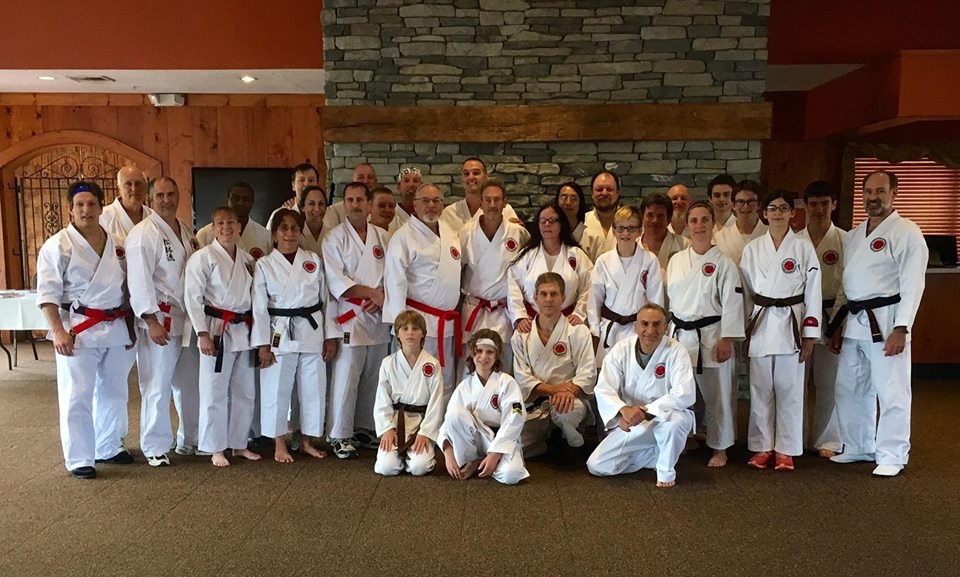










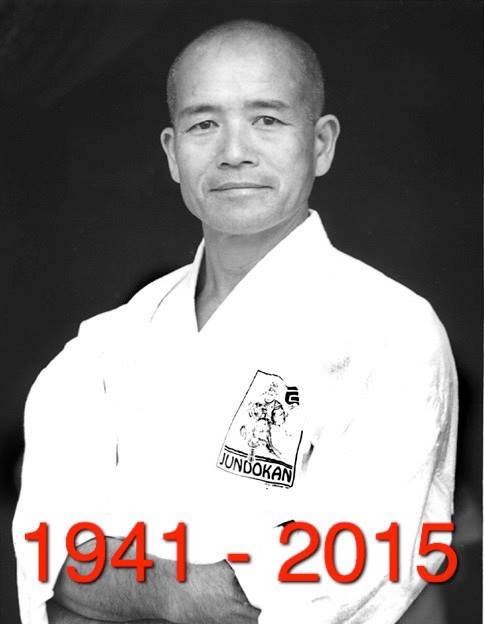 A huge loss to the martial arts world and the Goju Ryu community as Treuo Chinen Sensei has passed away at the age of 74. He had been one of the last surviving students who had learned directly from Chojun Miyagi and founded his own karate organization called Jundokan International. He is considered the best Okinawan Goju Ryu teacher outside Japan and is admired and respected throughout the martial arts world. He will be sadly missed.
A huge loss to the martial arts world and the Goju Ryu community as Treuo Chinen Sensei has passed away at the age of 74. He had been one of the last surviving students who had learned directly from Chojun Miyagi and founded his own karate organization called Jundokan International. He is considered the best Okinawan Goju Ryu teacher outside Japan and is admired and respected throughout the martial arts world. He will be sadly missed.

 John Hideo Huston was a Captain in the US Marine corps and a trained helicopter pilot however he was also a martial artist training at Ohio State back in the late 60's and early 70's, with many of Beisho's luminaries, who remember him fondly. He was a serious student and even vowed to wear a rope belt until he received his black belt. Sadly during a 1984 training mission in Korea his helicopter crashed and all were killed. He was just 34 years old. It is great news the hear Ohio State will honor him by naming a residence hall in his name. Read about his life below.
John Hideo Huston was a Captain in the US Marine corps and a trained helicopter pilot however he was also a martial artist training at Ohio State back in the late 60's and early 70's, with many of Beisho's luminaries, who remember him fondly. He was a serious student and even vowed to wear a rope belt until he received his black belt. Sadly during a 1984 training mission in Korea his helicopter crashed and all were killed. He was just 34 years old. It is great news the hear Ohio State will honor him by naming a residence hall in his name. Read about his life below.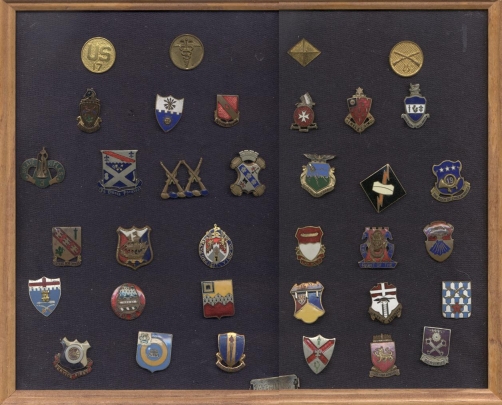 When my Dad passed away in 1981, he left with me a little box about 5"x4"x2" in size that contained several dozen enameled pins. It took me almost 20 years to get around to investigating them, but when I did, I found that they were World War U.S. Army Distinctive Unit Insignia (DUI), special pins that were authorized for wear by members of battalions, regiments, brigades, divisions, corps, and armies. (See photo.) In the box were also two personal identification badges, one of a member of the Royal Canadian Air Force and the other belonging to Thomas P. Standridge, U.S.A.
When my Dad passed away in 1981, he left with me a little box about 5"x4"x2" in size that contained several dozen enameled pins. It took me almost 20 years to get around to investigating them, but when I did, I found that they were World War U.S. Army Distinctive Unit Insignia (DUI), special pins that were authorized for wear by members of battalions, regiments, brigades, divisions, corps, and armies. (See photo.) In the box were also two personal identification badges, one of a member of the Royal Canadian Air Force and the other belonging to Thomas P. Standridge, U.S.A.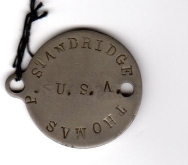 My Dad came to own these DUI because between about 1940 and 1943, he was in charge of all entertainment programs at Fort Benning, GA, the facility through which almost all soldiers headed to the European Theater passed either for basic training or advanced training as paratroopers, Rangers, or other specialized troops. Almost none knew it, but many were being trained for D-Day. In early 1943, Dad enlisted (he had previously served in a civilian capacity), but continued to do "double duty," going through simultaneous "boot camp" and Ranger training during most of the day, then planning, rehearsing, directing, em-cee'ing, and occasionally performing late into the night in the entertainment programs for the troops, radio programs in the area, and War Bond raising appearances. (This double duty almost killed him. He collapsed from exhaustion and various related illnesses in July 1943 and was discharged medically from the Army. The unit with which he was training was sunk in the English Channel on the way to Europe.)
My Dad came to own these DUI because between about 1940 and 1943, he was in charge of all entertainment programs at Fort Benning, GA, the facility through which almost all soldiers headed to the European Theater passed either for basic training or advanced training as paratroopers, Rangers, or other specialized troops. Almost none knew it, but many were being trained for D-Day. In early 1943, Dad enlisted (he had previously served in a civilian capacity), but continued to do "double duty," going through simultaneous "boot camp" and Ranger training during most of the day, then planning, rehearsing, directing, em-cee'ing, and occasionally performing late into the night in the entertainment programs for the troops, radio programs in the area, and War Bond raising appearances. (This double duty almost killed him. He collapsed from exhaustion and various related illnesses in July 1943 and was discharged medically from the Army. The unit with which he was training was sunk in the English Channel on the way to Europe.)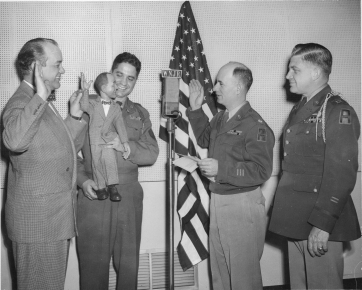 At most of the entertainment programs at Fort Benning, a representative of the unit or units in the audience would present my Dad with one of their DUI pins, and these were the ones I began to research almost two decades after his death, and more than 50 years after he had received them. I was able to identify most of the units, and it was sobering to think that many of the men who presented these pins to my Dad likely never came home from the War to marry or raise a family.
At most of the entertainment programs at Fort Benning, a representative of the unit or units in the audience would present my Dad with one of their DUI pins, and these were the ones I began to research almost two decades after his death, and more than 50 years after he had received them. I was able to identify most of the units, and it was sobering to think that many of the men who presented these pins to my Dad likely never came home from the War to marry or raise a family.